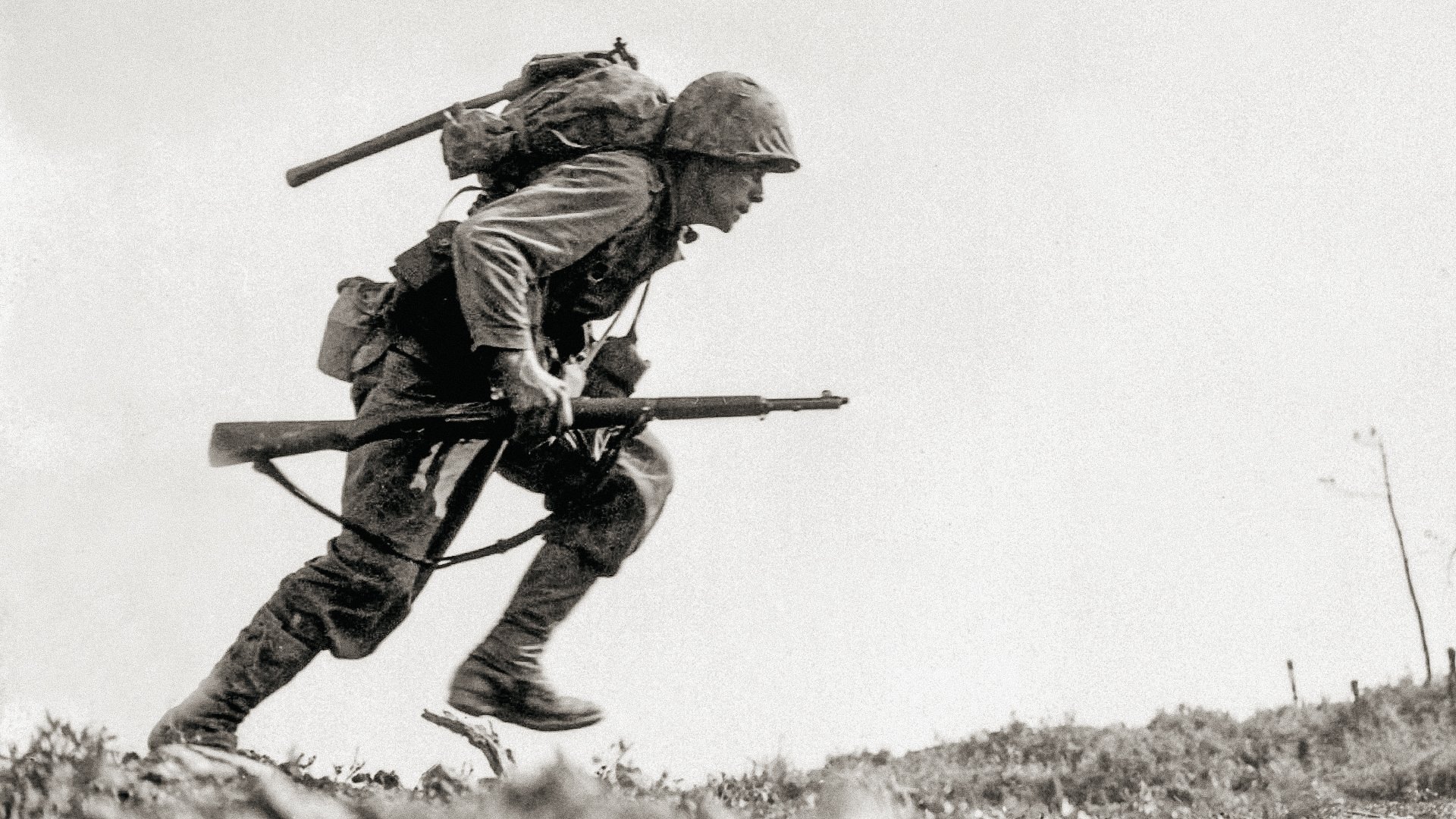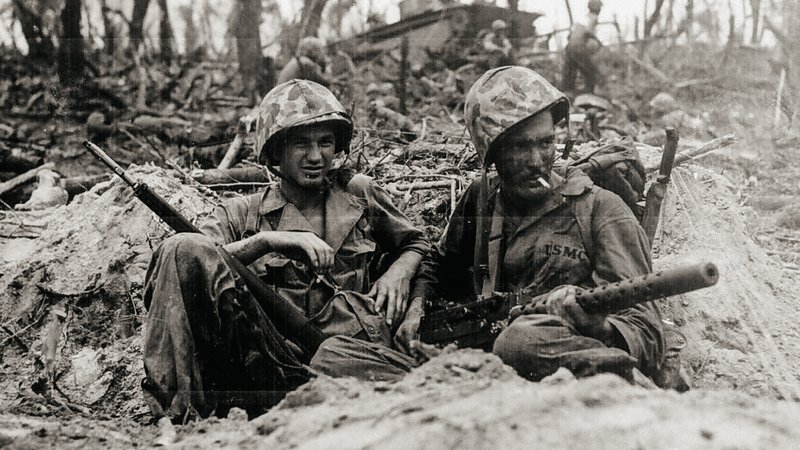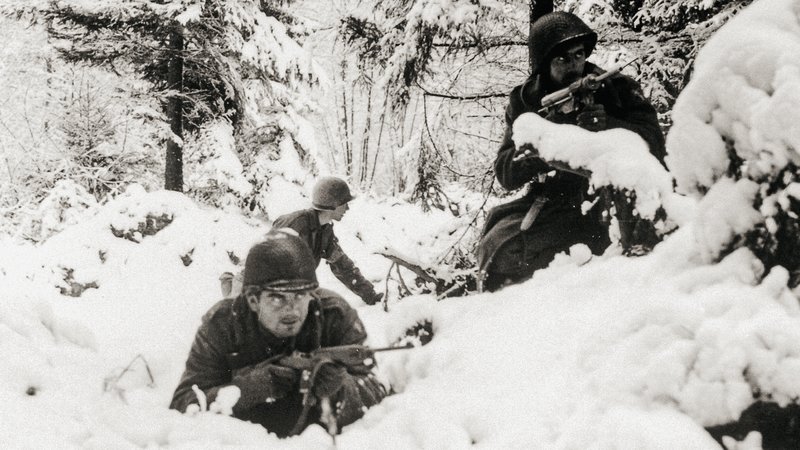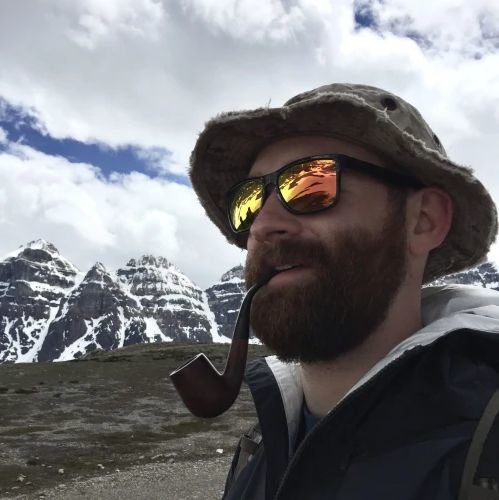Where Did American WWII Troops Have It Worse: In Europe or the Pacific?

Private First Class Paul E. Ison, a assistant BAR gunner with 3/5, dashes through Japanese machine gun fire while crossing a draw, on Okinawa, May 10, 1945. US Marine Corps photo by Pvt. Bob Bailey.
There’s a moving scene in the last episode of HBO’s World War II miniseries The Pacific. In it, one of the show’s protagonists — recently home from fighting in the Pacific — takes a taxi to his childhood home. Along the way, the driver explains that he, too, had served in the war, but in the European Theater. When they reach their destination, the driver refuses to accept a tip.
“I might’ve jumped into Normandy,” the driver says, “but at least I got liberties in London and Paris. You Gyrenes got nothing but jungle rot and malaria.”

American soldiers with the 89th Infantry Division cross the Rhine under heavy enemy fire. Photo courtesy of Wikimedia Commons.
Of course, the experiences of serving in the two theaters of WWII were different in ways that went beyond how troops enjoyed their downtime. One could even say that trying to compare the two is like comparing apples to oranges. But for argument’s sake, let’s try to answer the impossible question raised by our fictional taxi driver: Where did American service members have it worse: in Europe or the Pacific?

Marine Pfc. Douglas Lightheart (left) and Pfc. Gerald Thursby take a smoke break during the fighting on Peleliu, Sept. 14, 1944. Photo courtesy of Wikimedia Commons.
European Theater
Enemy
America’s primary foe in Europe — the German Wehrmacht — is considered by many historians to have been one of the most formidable armies in modern history. In battles throughout the war, Nazi soldiers consistently inflicted casualties at a rate 50% higher than American forces. That statistic seems even more remarkable when you consider that most of Germany’s best units were fighting the Soviets on the Eastern Front.
The Germans also had better tanks than the Allies. American tank crews found their thinly armored Shermans woefully inadequate in the face of the heavily armored German Tigers and Panzers. Fortunately for the Americans, what they lacked in armor they made up for in airpower. The German Luftwaffe was largely in shambles by the time American soldiers landed in Europe in 1944. The invasion force fought from France to Germany under skies dominated by a vast fleet of American aircraft.
Pacific Theater
Enemy
In order to maintain control over its fast-expanding empire, Japan had to thinly spread its military across the Pacific Theater. This left some of the more remote Japanese garrisons not just undermanned, but also under-equipped and unsupported. To compensate for their lack of resources, Japanese forces resorted to radical tactics. While the US Navy faced constant kamikaze attacks at sea, the GIs fighting ashore often had to contend with suicidal Banzai charges, in which entire units would rush headlong into American positions.

American soldiers of the 290th Infantry Regiment fight in fresh snow near Amonines, Belgium. Photo courtesy of Wikimedia Commons.
Weather
In addition to Nazis, American GIs serving in Europe had to contend with terrible weather. In the winter of 1944–1945, American troops in the Ardennes fought in temperatures that averaged 20 degrees below freezing. To make matters worse, most of the region was covered in deep snow. Under those miserable conditions, it was common for wounded soldiers to freeze to death before they could be evacuated.
Logistics
The liberation of Europe commenced on June 6, 1944, with the largest amphibious invasion in history — a full-blown assault on the Nazi-occupied beaches of Normandy, spearheaded by American forces. After the Allies secured the coastline and began pushing inland, some of their most urgent logistical challenges concerned the maintenance of roads. So long as the roads were in good condition, trucks could be used to keep frontline forces adequately fed and supplied as they fought their way east toward Berlin. Keeping that supply line open ensured that, barring outliers such as the Siege of Bastogne, American ground troops in Europe were, for the most part, kept well-nourished and well-armed throughout the war.
Weather
While the battlefields of Europe were a hellscape of snow and ice, troops deployed to the Pacific had to endure conditions at the opposite end of the severe-weather spectrum. Temperatures on islands such as Peleliu and Guam often reached 100 degrees Fahrenheit. And on the islands of Guadalcanal, Bougainville, and Okinawa, troops had to contend with months of heavy rainfall.
The heat and humidity greatly contributed to the spread of disease within the American ranks. In fact, troops in the Pacific were more likely to be taken out of the fight by malaria or dysentery than by wounds sustained in combat.
Logistics
While the D-Day landings remain the largest amphibious invasion in history, every battle in the Pacific began with logistically complex amphibious assaults. And in between battles, troops lived under constant threat from enemy submarines, ships, and aircraft as they traveled from objective to objective by sea. Since providing logistical support to ground forces required safe waterways, and the seas were teeming with enemy vessels, soldiers and Marines fighting ashore frequently found themselves without adequate food, water, and ammunition. Yet fighting on tiny islands did offer one major logistical advantage: the fire support of offshore ships.

A Marine takes aim at a Japanese sniper near the town of Shuri, during the battle for Okinawa. Photo courtesy of Wikimedia Commons.
Civilian Considerations
The risk of collateral damage and unwanted civilian casualties was a greater concern in Europe than in the Pacific. In the European Theater, soldiers often fought in densely populated cities, requiring them to make the extra effort of distinguishing between noncombatants and enemy soldiers before using less-precise weapons, such as artillery.
Concern over civilian casualties did not factor into how members of the US Army Air Corps conducted business, however. In fact, many bombing campaigns specifically targeted German civilians in an effort to diminish popular support for Hitler’s war. Historians estimate 500,000 German civilians died as a result of Allied bombing campaigns.
Civilian Considerations
Most battlefields in the Pacific Theater were scarcely populated by civilians. There were some major exceptions, however, including the Philippines, Okinawa, and Saipan. In Saipan, more than 1,000 civilians committed suicide ahead of the advancing Americans. Japanese soldiers had told them that US Marines would eat their children if they were captured.
Civilians would have played a larger role in the Pacific had the planned invasion of Japan taken place. Military planners expected some 20 million Japanese civilians to die in the invasion. In March 1945, Japan conscripted every male between the ages of 17 and 60 into the military — roughly a quarter of the country’s population. Four months later, a US Air Force intelligence report famously summarized the US military’s attitude toward Japan’s civilian population, stating, “There are no civilians in Japan.”

American soldier of the 1st Infantry Division storm Omaha Beach on June 6, 1944. Photo courtesy of Wikimedia Commons.
Combat Casualties
Approximately 141,000 American ground troops were killed in Europe — more than twice the number of those killed in the Pacific. An additional 42,500 were killed in the skies and at sea. Notably, 19,000 Americans were killed in a single engagement — the Battle of the Bulge — which is more than all of those killed in the battles of Tarawa, Iwo Jima, and Okinawa combined.
Combat Casualties
Fewer American troops were killed fighting in the Pacific than in Europe. However, this is because a much greater number of troops were involved in the European campaign. In fact, the casualty rate was nearly five times higher in the Pacific than it was in Europe. Additionally, the Pacific War is largely remembered as a Navy and Marine Corps affair, but that wasn’t actually the case. In the Pacific, 41,592 US Army soldiers died, in addition to the 23,160 US Marines and sailors who died fighting alongside them.
Read Next: Cutter 37: The Last Ship Standing

Mac Caltrider is a senior staff writer for Coffee or Die Magazine. He served in the US Marine Corps and is a former police officer. Caltrider earned his bachelor’s degree in history and now reads anything he can get his hands on. He is also the creator of Pipes & Pages, a site intended to increase readership among enlisted troops. Caltrider spends most of his time reading, writing, and waging a one-man war against premature hair loss.
BRCC and Bad Moon Print Press team up for an exclusive, limited-edition T-shirt design!
BRCC partners with Team Room Design for an exclusive T-shirt release!
Thirty Seconds Out has partnered with BRCC for an exclusive shirt design invoking the God of Winter.
Lucas O'Hara of Grizzly Forge has teamed up with BRCC for a badass, exclusive Shirt Club T-shirt design featuring his most popular knife and tiomahawk.
Coffee or Die sits down with one of the graphic designers behind Black Rifle Coffee's signature look and vibe.
Biden will award the Medal of Honor to a Vietnam War Army helicopter pilot who risked his life to save a reconnaissance team from almost certain death.
Ever wonder how much Jack Mandaville would f*ck sh*t up if he went back in time? The American Revolution didn't even see him coming.
A nearly 200-year-old West Point time capsule that at first appeared to yield little more than dust contains hidden treasure, the US Military Academy said.












